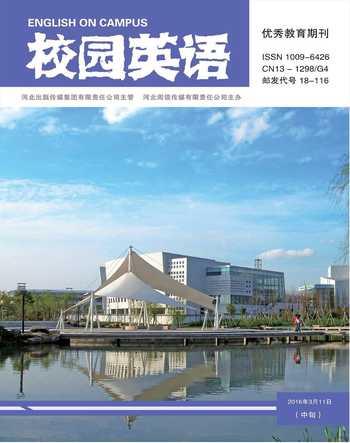Schema Theory and Translation
冉雨蒙
The word “schema” derives from the ancient Greek. The famous philosopher Kant firstly introduced this concept into philosophy domain. In his view, when human beings try to understand the new information, they will match the new information with what they have learned before, or the knowledge existing in the brain, thus, the schema was constructed (Kant,1781). In the twentieth century, the famous psychologist Piaget brought the concept into the field of cognitive psychology. According to his understanding, schema is the way in which people think and understand the world. It is a kind of mental activity, which plays a vital role in recognizing new things and it will developed with the development of human beings cognition system (Wang,2008). The Schema Theory also draws the attention of scholars in the translation circle. According to Zhang Meigang (2002), the schema is formed only when the translator fully understanding and analyzing the information in the source language. Zhou Hongmin (2003) thought that when the translator try to fully understand the information in the source context, the content schema will formed. While, in the translation process, the language schema will be constructed.
The translation process is the process in which the source language and the information in conveys will be transformed into the target language. It is not only a transformation of vocabulary and syntactic structure, but a transmission of information. Hence, the translator plays a vital role in this process. The translator needs to firstly fully and accurately understand the information in the text which needs to be translated. Then, the translator needs to analyze the factors which will influence the quality of translation and the understanding of readers when they read the translated text. Third, the translator needs to decode the source text and reconstructed the information in the way the target text demanded. When the translated text is encoded, the translator also needs to make sure that the meaning, the form and the content is intact.
From the prospective of Schema Theory, the translation process can be divided into two stages. The first one is decoding the source text and the second one is the reconstruction of the translated text. In the first stage, the translator needs to intensively read a wide range of reading materials, which is in relation to the source text and thus forms a knowledge system in the brain to help the translator fully understand the information in the source text. In the second stage, the translator retrieve the knowledge in the brain combined with the information in the source language, and embedded them in the target language. After these two stages, the translated text will be authentic, accurate and professional.
In the translation process, there are mainly three schemas will be used by the translator: language schema, content schema and culture schema. Language schema refers to the schema which is related to the vocabulary feature and syntactic structure. When the translator translates the source text, he needs to use language schema to analyze and reconstruct the text. Therefore, the vocabulary and syntactic knowledge will be needed. If the translator didnt use this schema, it will make the target text inauthentic, which will further make the reader hard to understand the information in the text. Content schema refers to the knowledge related to the source text. The translator needs to fully understand the information in the source text, and convey them in the target text accurately. Therefore, the richer the knowledge in the brain is, it will be easier to understand the information in the source text, express and transmit the information in the target text and to the readers. Language schema and content schema are complementary; they will help the translator to be more accurate in the translating process. Cultural schema refers to the cultural knowledge embedded in the target language and source language. The translator needs to familiar with these two language systems and use them correctly. Meanwhile, it is vital to acquire the related cultural knowledge, through which the authentic target text will be produced.
In the translation process, sometimes the translator will use the literal translation, which will not fully and accurately. The translator needs to effectively use the language schema to analysis the vocabulary feature, synthetic structure, sentence meaning and rhetorical meaning. If necessary, the translator needs to add some new words to ensure the accuracy of target text. In the translating process, because the translator needs to shift between two languages, it is important to grasp the differences and similarities between the two systems. As a result, the translator needs to use the language scheme to make translation process more smoothly and fluently. As is known to all, different languages have different expression in terms of a same meaning, the language scheme will enforce the translator to change different syntactic structures or patterns, and highlight the differences between different languages. Hence, the target text will be authentic and accurate. It is known to all that different language entails different cultural backgrounds, and the usage of language is an expression of culture, which the translator must be aware of. Therefore, the translator should try to enlarge the knowledge about different cultures and the cultural background, enrich the specialist knowledge, vocabulary in different discipline and some unique features, minimize the translation problems caused by different cultural backgrounds.
Schema plays a vital role in translation process and is important to the translator. For the translator, effective usage if language schema, content schema and culture schema will make the translation easier and more fluent. Translation process is a process in which the information embedded in the source language will be decoded and encoded again in the target language, therefore, appropriate usage of different schemas will have a positive effect on this process.
參考文獻(xiàn):
[1]Bartlett F.C.Remembering:An Experimental and Social Study[M].Cambridge:Cambridge University Press,1932.
[2]Kant.Critique of Pure Reason[M].London:The Macmillan Press,1781.
[3]Piaget,Jean.The Principles of Genetic Epistemology[M].London:Routledge,1997.
[4]陳偉星.圖式理論在翻譯中的運(yùn)用[J].渤海大學(xué)學(xué)報(bào),2006.
[5]劉明東.圖式翻譯漫談[J].外語教學(xué),2004.
[6]劉明東.文化圖式的可譯性及其實(shí)現(xiàn)手段[J].中國翻譯,2003.
[7]劉瀟,李孝奎.圖式理論在翻譯中的應(yīng)用[J].雙語學(xué)習(xí),2007.
[8]王立弟.翻譯中的知識(shí)圖式[J].中國翻譯,2001.
[9]王宇新.論翻譯過程中的圖式應(yīng)用[J].北京第二外國語學(xué)院學(xué)報(bào),2008.
[10]薛海萍.論圖式理論對翻譯的影響[J].青海師范大學(xué)學(xué)報(bào),2006.
[11]張梅崗.論翻譯的圖式文本[J].中國翻譯,2002.
[12]周紅民.翻譯圖式解析[J].上??萍挤g,2003.
[13]周篤寶.圖式理論對理解翻譯的解釋力[J].南華大學(xué)學(xué)報(bào),2002.

